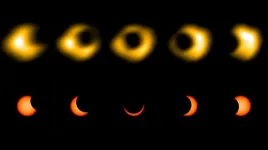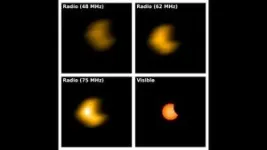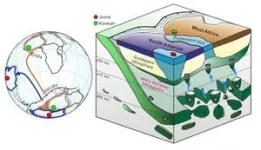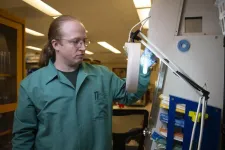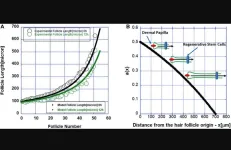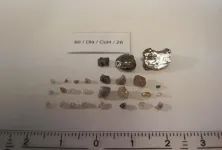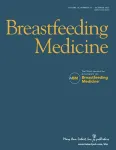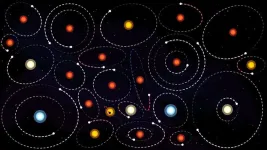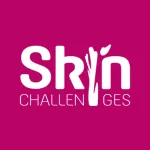(Press-News.org) Researchers at New Jersey Institute of Technology’s Center for Solar-Terrestrial Research (NJIT-CSTR) have captured the Oct. 14 solar eclipse in a way never seen before — recording the first radio images of an annular eclipse’s famous “ring of fire” effect.
The eclipse was partially visible to much of the continental U.S. for several hours that Saturday, though the full “ring of fire” effect was only visible for less than five minutes, and only for those within its 125-mile-wide path of annularity.
However, the new observations of the radio Sun’s eclipse — much longer in duration than the partial eclipse recently experienced by millions on Earth due to the extended solar corona as seen at radio wavelengths — have yielded stunning images of the eclipse’s ring lasting for over an hour.
Researchers used the newly commissioned Owens Valley Radio Observatory Long Wavelength Array (OVRO-LWA) in the Owens Valley Radio Observatory, CA to make their breakthrough observation of radio waves emanating from the Sun's extended corona, as the moon passed between Earth and its nearest star.
“To finally see a ‘ring of fire’ eclipse this way was spectacular … we haven't seen this quality of radio imaging of the Sun before.” said Dale Gary, NJIT-CSTR distinguished professor of physics and co-investigator on the OVRO-LWA project, which is funded by the National Science Foundation.
“We normally cannot see the corona from the ground except during a total eclipse, but we can now see it all the time with OVRO-LWA. This eclipse makes it that much more dramatic.”
“From our observatory site in California we were not in the belt to see the annular eclipse, yet we’ve been able to ‘see’ it all clearly unfold in radio, which reveals a much larger solar disk than its visible counterpart thanks to its sensitivity to the extended solar corona,” said Bin Chen, NJIT-CSTR associate professor of physics who led the data reduction and processing together with NJIT researchers Surajit Mondal and Sijie Yu.
“Science-wise, this is a unique opportunity to study the Sun’s extended corona with the highest resolution possible at these wavelengths, taking advantage of the moon’s limb as a moving ‘knife edge’ to increase the effective angular resolution,” said Chen.
OVRO-LWA, a multi-institutional project directed by Gregg Hallinan at California Institute of Technology, uses a set of 352 antennas to sample thousands of radio wavelengths between ~20-88 MHz.
For solar science, it offers the highest-quality images yet of the radio Sun in this wavelength regime, which is roughly two times larger than the visible solar disk.
“Documenting this spectacular event was a great opportunity to announce the successful operation of OVRO-LWA as a new radio facility to study the Sun and many other objects including exoplanets, cosmic-rays, the early universe, and more,” said Hallinan.
While the next annular solar eclipse is expected to be visible from South America in October 2024, those in the U.S. will need to wait until June 2039 to view the next ‘ring of fire’ eclipse on home soil. However, a total eclipse visible across the central U.S. will occur sooner, next April 8.
However, the team say the recent eclipse event is an outstanding example of the first observations of the Sun with the instrument. With the new capabilities OVRO-LWA offers, exciting science is expected in the near future — particularly as solar activity of the current 11-year solar cycle peaks in 2025 during the expected "solar maximum.”
“We are now working on an automated data processing pipeline that will soon produce near-real-time solar images and make them available to the public,” said Chen. “These eclipse images serve as a proof-of-concept for this effort. The unprecedented data products coming soon will open new opportunities for discovery in solar astronomy and space weather studies.”
END
Researchers capture first images of a radio 'ring of fire' solar eclipse
2023-10-23
ELSE PRESS RELEASES FROM THIS DATE:
University of Montana leads $12.3 million contract to advance TB vaccine
2023-10-23
MISSOULA – The National Institutes of Health recently awarded a $12.3 million contract to the University of Montana to develop a novel vaccine adjuvant for use in a tuberculosis vaccine. Adjuvants are substances that boost the effectiveness of vaccines.
The five-year award went to UM’s Center for Translational Medicine and its partners. The contract is titled “Development of UM-1098: A Novel Synthetic Th17 Inducing Adjuvant and Delivery System.”
“The development and clinical evaluation of safe and effective ...
People who communicate more, show expertise are more likely to be seen as essential team members
2023-10-23
A new study sheds light on the vital role of communication and expertise within organizations, revealing their impact on group performance. Researchers examined how individuals become part of communication networks and the effect of selection processes on group performance. The study found that people who communicated more during training were more likely to be chosen as a central member of the network. In addition, teams that chose their central member performed as well as and often better than teams whose central member was randomly assigned.
The study, by researchers ...
Apoptotic cells may drive cell death in hair follicles during regression cycle
2023-10-23
“Revealing the stem cell niche self-renewal dynamics is important not only for understanding tissue homeostasis but also for understanding the initiation of cancer [7].”
BUFFALO, NY- October 23, 2023 – A new research paper was published in Oncotarget's Volume 14 on October 19, 2023, entitled, “Apoptotic cells may drive cell death in hair follicles during their regression cycle.”
Intravital microscopy in live mice has shown that the elimination of epithelial cells during hair follicle regression involves supra-basal cell differentiation and basal cell apoptosis through synergistic action of TGF-β (transforming ...
$3.6 million NIH award funds research to treat painful diabetic neuropathy
2023-10-23
COLUMBUS, Ohio – A $3.6 million award from the National Institutes of Health will allow neurosurgical, neurology and neuroscience researchers at The Ohio State University Wexner Medical Center and College of Medicine to test a novel diagnosis and treatment combination for painful diabetic neuropathy. The approach combines spinal cord stimulation with measurement of small fiber nerve activity using a patent-pending device called Detecting Early Neuropathy (DEN).
Diabetes is a growing health concern worldwide, ...
Superdeep diamonds provide a window on supercontinent growth
2023-10-23
Washington, DC—Diamonds contain evidence of the mantle rocks that helped buoy and grow the ancient supercontinent Gondwana from below, according to new research from a team of scientists led by Suzette Timmerman—formerly of the University of Alberta and now at the University of Bern—and including Carnegie’s Steven Shirey, Michael Walter, and Andrew Steele. Their findings, published in Nature, demonstrate that superdeep diamonds can provide a window through space and time into the supercontinent growth and formation ...
American Cancer Society awards pilot funding to University of Cincinnati Cancer Center for early-stage investigators
2023-10-23
The American Cancer Society has awarded the University of Cincinnati Cancer Center an Institutional Research Grant.
Cancer Center member David Plas, PhD, is primary investigator for the grant, with members Maria Czyzyk-Krzeska, MD, PhD, and Kathryn Wikenheiser-Brokamp, MD, PhD, serving as co-principal investigators.
The American Cancer Society awards Institutional Research Grants to academic and nonprofit organizations that have a track record of outstanding cancer research and a pool of experienced researchers who can mentor junior faculty. The purpose is to support early-stage ...
Climate is increasing risk of high toxin concentrations in Northern US lakes
2023-10-23
Washington, DC— As climate change warms the Earth, higher-latitude regions will be at greater risk for toxins produced by algal blooms, according to new research led by Carnegie’s Anna Michalak, Julian Merder, and Gang Zhao. Their findings, published in Nature Water, identify water temperatures of 20 to 25 degrees Celsius (68 to 77 degrees Fahrenheit) as being at the greatest risk for developing dangerous levels of a common algae-produced toxin called microcystin.
Harmful algal blooms result when bodies of water get overloaded with nitrogen and phosphorus ...
Breastfeeding in the setting of substance use
2023-10-23
The Academy of Breastfeeding Medicine (ABM) has released new literature-based recommendations related to breastfeeding in the setting of substance use and substance use disorder (SUD) treatments. The new clinical protocol is published in the peer-reviewed journal Breastfeeding Medicine. Click here to read the article now.
Miriam Harris, MD and Elisha Wachman, MD, from Boston Medical Center, and coauthors, provide breastfeeding recommendations in the setting of non-prescribed opioid, stimulant, sedative-hypnotic, alcohol, nicotine, and cannabis use, and SUD treatments. They also offer guidance on the use of toxicology testing in breastfeeding ...
New exoplanet-informed research sets clearer bounds on the search for radio technosignatures
2023-10-23
A new study leverages the NASA Exoplanet Archive and planetary system simulations to make narrowband SETI searches more efficient.
October 23, 2023, Mountain View, CA -- In a new study published in the Astronomical Journal, researchers used the known population of exoplanets and extrapolated to the much larger, unknown population of exoplanets to set better thresholds for planetary effects on signals from ETIs (extraterrestrial intelligences). The prior recommendation for the threshold “drift rate” contribution, caused by a planet’s motion around its host star, was 200 nHz. In this work, lead ...
Navigating the future of skin health: The 14Th International Conference on Skin Ageing & Challenges 2023
2023-10-23
Lisbon, Portugal – 23 October, 2023
The International Society of Microbiota (ISM) is proud to present the 14th International Conference on Skin Ageing & Challenges 2023. This monumental event will unfold at the Altis Grand Hotel in Lisbon, Portugal, and virtually, on November 9-10, 2023.
Skin ageing, a multifaceted issue combining both basic research, mechanistic, clinical aspects and health concerns, is gaining significant attention in the scientific community.
This year’s conference promises to be a beacon of innovation, ...
